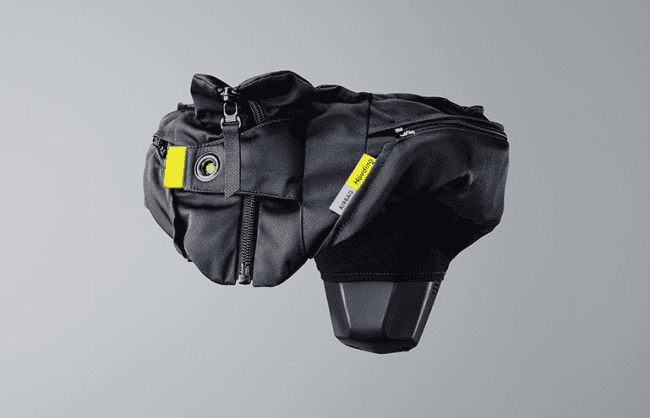Hövding 2.0

Safety in cycling is one of the biggest worries I’ve often seen worried over. It cannot be stated enough how important gear like a proper helmet can be for the odd accident that almost certainly will happen. The classical bike helmet is effective, but it doesn’t mean it’s the only option people are testing today.
Swedish startup Hövding has an unique product that aims to offer a new method of protection for cyclists. Listed on their website as being confirmed by Stanford researchers to have 8x’s better protection than traditional bike helmets, the Hövding 2.0 is an interesting product to look at. How safe of an idea does it turn out to be though?
Hövding 2.0 Features
Designed to mitigate catastrophic injury, the Hövding helmet senses a cyclist’s unorthodox movement patterns immediately after impact. This deploys the company’s shock absorbing helmet when needed without it being overly sensitive. When activated the air bag around the user’s neck inflates to protecte the cyclist’s head from whiplash, concussions, and other potential injuries.
Safety is paramount when riding anything, from a car to a bike, so the added protection is not unwarranted. Though it sounds simple, I think the overall process is a bit more complicated than one might think at first.
Strategically housed within its waterproof collar, Hövding’s built-in airbag system records a cyclist’s movement 200 times a second. The airbag inflates only when it detects an unusual body position. When deployed the device covers all of the vital areas in and around your neck and head.
Hövding 2.0 Design
According to the Stanford University study, “the thickness and stiffness of the Hövding helmet is “near perfect” in terms of protecting against concussions and head injuries caused by accidents.” The study concludes that there is “an eight-fold reduction in the risk of concussion with a Hövding 2.0 airbag compared to traditional helmets.”
This is a good backing for the product, but it’s not the be all end all. It’s good to see what users of the product think, and to look at the level of practical safety offered when compared to a bike helmet. What is it that this will save you from that a bike helmet wouldn’t and such.
Designed like a hood and made out of ultra-strong nylon fabric, the Hövding 2.0 airbag system protects nearly all of the rider’s head and has been rigorously tested. According to Hövding’s site, “the pressure remains constant for several seconds, making it able to withstand multiple head impacts during the same accident – after that the airbag slowly deflates.”
The technology is rather impressive, to say the least. Using helium gas to inflate the airbag, Hövding ergonomic design is strategically positioned on the cyclist’s collar. Hövding’s proprietary tech, which includes sensor and algorithms, is the result of testing thousands of re-enacted cycling accidents using crash-test dummies.
Though the claims are that this newer model is more comfortable to the previous, that doesn’t mean it’s the nicest feeling fit in the world. Many do claim that it doesn’t feel as awkward to wear as the 1.0 model, but it’s still awkward to walk around in. New advancements might mitigate this in the future, but for now the comfort is still one of the biggest downsides when you get your hand on the product.
Since the technology is so new and unfortunately studying real-world accidents is a necessary evil in order to improve its airbag system, Hövding has installed its version of a black box inside the collar. This is a little bit of a morbid addition, though it doesn’t impact the use of the product in many meaningful ways as far as how the average consumer will use it.
Recording 10 seconds of movement patterns from an accident allows Hövding designers to make adjustments to their algorithm. With Stanford University’s seal of approval and CE approval by the SP Technical Research Institute in Sweden, Hövding may just be the safest helmet on the streets today.
Final Thoughts
Interesting, advance, and attempting to find new ways to protect people, these are all ways I would describe the Hövding 2.0. For some people a simple old fashioned bike helmet is all they will ever want or need, but being safer is something that everyone should be looking for.
It’s not fashionable, there are claims that it’s uncomfortable to wear, but it is a safe option to chose. Practical products that aim to have real world uses aren’t often the best looking things, but sometimes it’s a sign that all the effort went into how it works.
I would recommend looking further into the Hövding 2.0 and any other models that come after it if you’re an avid biker that moves around in risky areas. You can never be too careful when out on your wheels.
- Strong head protection
- CE marked
- On/Off Zip Pull Feature
- Waterproof Functional Fabric
- Not offered in many countries
- Low availability
- Claims of being uncomfortable
- Not the best looking when worn



